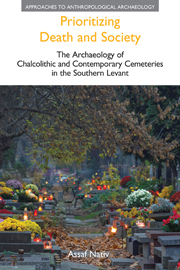 Prioritizing Death and Society
Prioritizing Death and Society Book contents
- Frontmatter
- Dedication
- Contents
- List of figures
- List of tables
- Acknowledgements
- Part I Introduction
- Part II Chalcolithic cemeteries
- Part III Contemporary cemeteries
- 10 An archaeology of us
- 11 The raw materials: from matt to lustre, from grey to colour
- 12 Tombstone morphology: communal trajectories
- 13 Tombstone elaboration: personal expressions
- 14 Spatial patterns: between institutional policy and interpersonal spontaneity
- 15 Intersecting discourses
- Part IV Conclusion
- Appendix: Gazetteers of cemeteries
- Notes
- Bibliography
- Index
14 - Spatial patterns: between institutional policy and interpersonal spontaneity
from Part III - Contemporary cemeteries
- Frontmatter
- Dedication
- Contents
- List of figures
- List of tables
- Acknowledgements
- Part I Introduction
- Part II Chalcolithic cemeteries
- Part III Contemporary cemeteries
- 10 An archaeology of us
- 11 The raw materials: from matt to lustre, from grey to colour
- 12 Tombstone morphology: communal trajectories
- 13 Tombstone elaboration: personal expressions
- 14 Spatial patterns: between institutional policy and interpersonal spontaneity
- 15 Intersecting discourses
- Part IV Conclusion
- Appendix: Gazetteers of cemeteries
- Notes
- Bibliography
- Index
Summary
Theoretically, concepts of time and space are complementary, representing distinct but compatible lines of enquiry and observation. In practice, however, analytical choices in favour of one are often realized at the expense of the other. Thus, the temporal analyses offered in the three preceding chapters were made possible only by considering the tombstones and graves as singular isolated units and by entirely relinquishing issues of spatial patterning.
By the same token, a choice in favour of spatial relations implies a weaker hold over the temporal dimension, which, if taken to the extreme, is likely to induce a complete disjuncture with the previous chapters. This is clearly undesirable. Fortunately, the shift in this chapter towards the spatial dimension does not necessarily demand that the temporal dimension be relinquished altogether. Often graves in close physical proximity were observed to be in temporal proximity as well. Spatial clusters can therefore be arranged in relative temporal order, revealing development and allowing some inference into the processes at work.
Two features of cemetery organization will be considered here. One is the occurrence of explicit expressions of association between graves, and the other refers to the distribution of the sexes. In both cases, patterns for several spatial units within each cemetery will be explored; these will subsequently be arranged in relative temporal order, thus offering a glimpse into possible temporal trends.
Explicit association
All contemporary cemeteries in Israel share the same underlying structure.
- Type
- Chapter
- Information
- Prioritizing Death and SocietyThe Archaeology of Chalcolithic and Contemporary Cemeteries in the Southern Levant, pp. 173 - 183Publisher: Acumen PublishingPrint publication year: 2013


